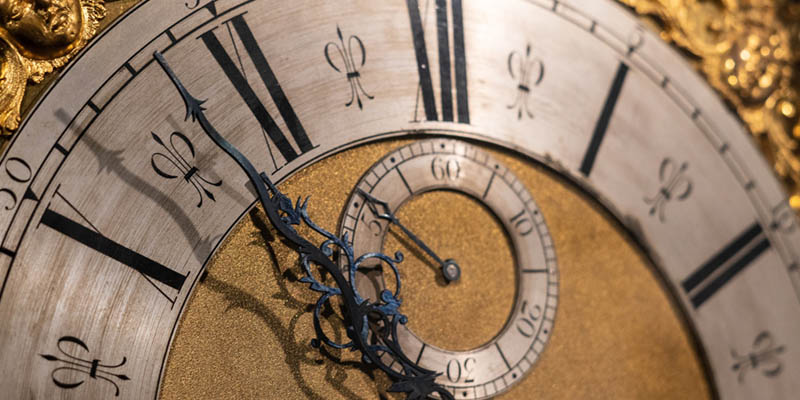In total more than 1.6 billion people living in 76 countries around the world will be impacted by this phenomenon. Hour by hour around the globe people will be systematically disproving the old adage “You Can’t Turn Back the Clock.”
Today many computers, digital clocks and electronic devices reset automatically, making this process quite a bit easier than in the past. But for people who own antique mechanical clocks, this task can be more daunting. This is because the hands of antique clocks cannot be turned counter clockwise without damaging the clockwork mechanism.
At any given time Solvang Antiques display a fascinating array of timepieces in their showroom. What do you do when you have many antique clocks to reset and the minute hand cannot be turned backwards?
The safest way is also the easiest. Simply stop the pendulum from swinging for about an hour. Then start it again and adjust the timekeeping.
The alternative method is to advance the hour hand, slowly and carefully, eleven times around the dial until the correct hour is reached – however this requires pausing to allow the clock to strike completely every hour, half hour or quarter hour, depending upon the individual clock. When you only have one antique clock this will only take a few minutes, but when you’re a collector with dozens of antique clocks or an antique clock dealer with hundreds of clocks to reset, the former method is far more time-efficient.
For additional helpful tips about operating antique clocks – from how to set your clock and adjust the timekeeping to what to do if the strike is out of synch with the time reading on the clock dial – Solvang Antique’s website offers some “timely” information for you. You can access this information in the footer by choosing “Antique Articles” under Resources.
A Brief History of Daylight Saving Time
Daylight Saving Time has been a controversial topic of debate in the United States ever since its inception over a century ago. Introduced by Britain in 1916 as a means of conserving coal during wartime, the US followed suit in 1918. At the end of WWI Daylight Saving Time was discontinued, its repeal sparked by protests from farmers. Their influence, however, was no match for that of Wall Street, which favored the concept because it allowed a one hour window in the morning when both the NY Stock Exchange and London Stock Exchange were open simultaneously.
Exchanges in Boston and Philadelphia soon followed suit, creating small islands of disparate time within the nation and resulting in considerable confusion. As an example, if you drove the 35 miles between Steubenville, Ohio and Moundsville, West Virginia and attempted to keep your watch matched to local time, you would need to reset it no fewer than seven times!
During World War II President Roosevelt instituted “War Time” from 1945 to 1946, and localities were free to decide whether to observe Daylight Saving Time or not, and could even choose their own beginning and end time. This caused further confusion until President Nixon signed the DST Energy Act of 1973 into effect.
The federal law that established “daylight time” in the United States does not require any area to observe daylight saving time. But if a state chooses to observe DST, it must follow the starting and ending dates set by the law. From 1986 to 2006 this was the first Sunday in April to the last Sunday in October, but starting in 2007, it is observed from the second Sunday in March to the first Sunday in November, adding about a month to daylight saving time.
Today all 50 states except for Arizona and Hawaii observe Daylight Saving Time. Telling time in Indiana however remains something of a bewildering experience: eighteen counties now observe Central Daylight Time and the remaining 74 counties observe Eastern Daylight Time.

